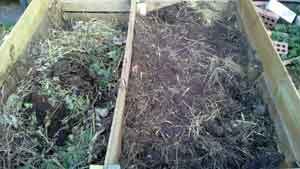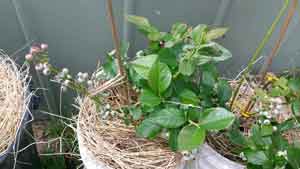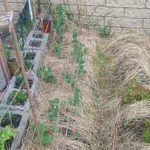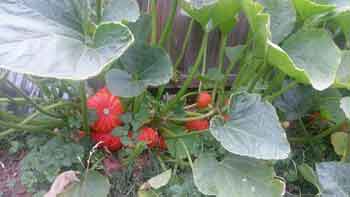Megan Ambrus, one of SGA’s subscribers has written this inspiring account of her gardening experience. Thank you, Megan!
Growing up on a farm we always grew our own food and space was never an issue. The kitchen led straight into an orchard, that had been there in one form or another since the house was built around 1800.
Tree branches bowed with the weight of apples, figs, walnuts and mulberries among many others. The vegetable gardens overflowed with corn, beans, tomatoes, cucumbers and just about every other vegetable able to grow in the region. Herb gardens produced a myriad of fresh herbs. What wasn’t used or given away was composted or went to the chickens.
I moved to Hobart in 2000. Living in a unit, my yard was a tiny patch of cement. It left me so frustrated I stopped gardening and for the next fifteen years, my only plants were potted flowers. Yet, the desire to grow my own food never left me. In 2015 I moved to my current location with a small backyard and it gave the motivation to start food gardening again. Challenges soon arose.
The first was composting. I bought a black plastic compost bin. Everyone else I knew with a garden used them so I figured it was the way to go. The material in the bin turned in mass of stinking wet sludge. Even my neighbours complained about the smell.

On the farm, composting bins were nothing more than three sided wooden frames producing lovely rich compost. After the disaster with the plastic bin, I returned to this method and built a couple of bins from recycled wood. The end product was beautiful moist compost with a lovely earthy smell.
Having sorted that issue, I turned my attention to creating some gardens. My soil was heavy clay soil; boggy in the winter and rock hard in the summer. I decided to use raised beds instead.
Soon after in 2015 I lost my job and there was suddenly no spare money to purchase ready-made raised beds or the materials to build what I wanted.
I decided to plant directly in the ground. It took some hard work over the winter but eventually I got the clay soil to a stage it was suitable to grow in. In spring 2015 I created two gardens and got some plants in the ground. I soon realised my little plots were not going to be sufficient as I wanted to produce a variety of foods. I had two choices. I could stick with growing only a few things in my plots or I could use containers.
The first attempt at container gardening in the spring/summer of 2015/16 failed miserably. Everything died. When I finally admitted defeat and pulled them out I found a wet stinking mass of soil in the containers. Not prepared to surrender so easily, I spent autumn and winter of 2016 researching container growing and what had gone wrong.
My first big mistake was putting soil in the containers. My second was using plants that simply weren’t well suited. My third was overwatering. My fourth was using containers that were simply too big. The roots of the plants were not filling the entire space, resulting in compacting wet soil beneath. My poor plants just couldn’t cope.
In the spring of 2016, with the ground plots doing well for a second season, I was ready to try container gardening again.
This time, I did some planning rather than just sticking things in randomly. I used potting mixes with some of my compost as well more appropriate containers sizes for the various plants.

I researched the plants I wanted to grow in containers so I understood their needs. I raised the containers on bricks to aid in drainage and mulched properly. I made sure I checked if they actually needed watering rather than just drowning them regardless.
I was rewarded. The two plots produced an abundance of corn, peas and other foods. My herb and vegetable container gardens gave me among other things, blueberries, carrots, tomatoes, parsley and chives.

There was so much I couldn’t possibly use or preserve everything. Not liking to see food go to waste the excess went others and community food programs and waste matter composted.
In 2017/18 I added dwarf fruit trees, cape gooseberries and other berries to the container garden.
The 2018/19 garden was grown from all my own seed.
Pests
On the farm, we never used chemical or poisons and never had a major problem with pests. The dogs kept the herbivores away and the owls removed rodents. The blue tongues took care of snails and the birds and insect predators cleaned up other pests.
The birds did eat the fruit and the blue tongues loved the strawberries but with such an abundance, sharing it with them as a reward for removing pests was never a problem.
Here in my little suburban garden it’s no different. The herbivores don’t like the dogs so they stay away. The birds take care of problem caterpillars and other pests. The two resident blue tongues gorge on snails and an army of ladybirds and other predator insects appear to keep aphids and other pests under control.
Last year two owls moved into a nearby tree. This year, they hatched two babies and I’ve had the privilege of watching the family come at night. They’d perch on aviary, the parents swooping down to catch the rats living under the aviary, feeding their fledglings before consuming their own dinner.
As a result rodent poison is banned in my garden as poisoned rats kill the owls through secondary poisoning. Snail bait is banned as well as it also kills blue tongues and birds if they eat dead and dying snails.
The absence of poisons and chemical sprays means I have an array of beneficial bird, insect and reptile life visiting my garden. I’m happy for the birds and blue tongues to take a bit of produce in return for their work.
Nature’s natural pest controllers are a far better option than poisons and chemical sprays.
In conclusion
Starting a suburban garden had its challenges. On the farm unlimited space meant no containers and growing whatever one pleased.
In suburbs I have to think carefully about what I really want to grow and how I will use available space. The pumpkins and other vining plants grow on trellis instead of taking as much ground space as they please and I now grow some bush varieties that don’t vine.
Suburban gardening means more planning and being choosey about what I grow. It means there are things we grew on the farm I can only dream about growing in the suburbs due to limited space.

Yet I have produced a healthy garden with so many more varieties of food plants than I thought possible in a small space. What isn’t used, preserved or given away is composted.
I’d love to be back on the farm, yet the challenge of finding ways to grow good food in a small suburban backyard and still produce more than enough to feed myself and others is very satisfying.
Now to find a bit of space for a couple of hens…
Related Articles:
Tomato Brown Rugose Fruit Virus (ToBRFV)
Tomato Brown Rugose Fruit Virus (ToBRFV) is a plant virus that causes severe crop losses (up to 75%) in tomatoes, but also in peppers (capsicums and…
Garden Journaling – Slow down to tune in.
As we move through the year and our gardens evolve, there's something magical about documenting the journey. Garden journaling is an art that enables…


